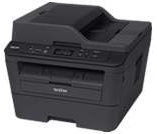
The Brother DCP-L2540DN is a versatile printer, similar to the DCP-L2560DW, but with some minor variations. Other models in the same series include the DCP-L2540DN, MFC-L2720DW, DCP-L2500D, DCP-L2520DW, MFC-L2700DW, and MFC-L2740DW. The DCP-L2540DN boasts an internal memory of approximately 32 MB of RAM.
Brother DCP-L2540DN printer driver for Windows
| Filename | Size | Download |
| Printer Full Drivers for Windows 7 8 8.1 10 vista xp 32 bit and 64 bit.EXE | 165.64 MB |
Brother DCP-L2540DN driver for Mac
| Filename | Size | Download |
| Printer Full Drivers for Mac 10.14.dmg | 344.23 MB | |
| Printer Full Drivers for Mac 10.9 to 10.13.dmg | 344.48 MB | |
| Printer Full Drivers for Mac 10.8.dmg | 344.56 MB | |
| Printer Full Drivers for Mac 10.7 to 10.11.dmg | 22.35 MB |
Specifications
The device boasts a cutting-edge touchscreen interface that can recognize up to 16 distinct characters across two lines. Featuring a TFT color touchscreen LCD and a touch panel measuring a mere 2.7 inches (67.5 mm) diagonally, this printer is a marvel of precision engineering. It is compatible with a variety of print languages, including PCL6 and BR-Script3 (a Postscript 3), and boasts a print resolution of 600 x 600 dpi. For top-of-the-line quality, the maximum resolution reaches an impressive 2400 x 600 dpi.
The duplex component of this printer allows for automatic double-sided printing, with an average rate of 7.5 sheets per minute on A4 size. The complexity of the document can affect this rate. Additionally, the printer has a regular print speed of approximately 30 pages per minute on an A4, with a first-page printing time of less than 8.5 seconds at a temperature of 230C.
To establish a connection with this device, three primary options are available. The first is through the main universal serial bus (USB), utilizing the hi-speed USB 2.0 port. It is crucial to use the recommended USB cable from the manufacturer, which should not exceed 2.0 meters in length.
Another alternative is the LAN connection for networking, which necessitates the utilization of 10BASE-T or 100BASE-TX components. A straight-through category 5 or higher is required for this type of connection.
In addition to its impressive features, the printer also boasts Wireless connectivity capabilities, supporting IEEE 802.11b/g/n connections in a regular infrastructure, Ad-hoc, or WI-Fi direct. It’s important to note, however, that this printer does not support third-party USB. Users should also be aware of the supported network protocols, which include WINS/NetBIOS, DNS, ARP, RARP, DHCP, BOOTP, and several others.

